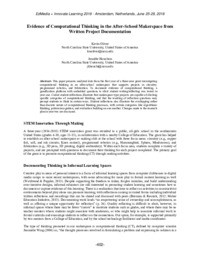Evidence of Computational Thinking in the After-School Makerspace from Written Project DocumentationKevin Oliver, Jennifer Houchins
Zu finden in: EdMedia 2018, 2018
|
 |
 Diese Seite wurde seit 6 Jahren inhaltlich nicht mehr aktualisiert.
Unter Umständen ist sie nicht mehr aktuell.
Diese Seite wurde seit 6 Jahren inhaltlich nicht mehr aktualisiert.
Unter Umständen ist sie nicht mehr aktuell.
 Zusammenfassungen
Zusammenfassungen
This paper presents analyzed data from the first year of a three-year grant investigating computational thinking in an after-school makerspace that supports projects in circuitry, programmed robotics, and fabrication. To document evidence of computational thinking, a gamification platform with embedded questions to elicit student writing/reflecting was tested in year one. Coded student reflections illustrate that makerspace-type projects are capable of eliciting specific categories of computational thinking, and that the wording of reflection questions may prompt students to think in certain ways. Student reflections also illustrate the overlapping rather than discrete nature of computational thinking processes, with certain categories like algorithmic thinking, pattern recognition, and evaluation building on one another. Changes made to the research plan in year two are discussed.
Von Kevin Oliver, Jennifer Houchins im Konferenz-Band EdMedia 2018 (2018) im Text Evidence of Computational Thinking in the After-School Makerspace from Written Project Documentation  Dieses Konferenz-Paper erwähnt ...
Dieses Konferenz-Paper erwähnt ...
 Personen KB IB clear | Jeannette M. Wing | ||||||||||||||||||
 Begriffe KB IB clear |  Algorithmus Algorithmus algorithm
, computational thinkingcomputational thinking
, GamificationGamification
, algorithm
, computational thinkingcomputational thinking
, GamificationGamification
,  Roboter Roboter robot robot
| ||||||||||||||||||
 Texte |
|
 Zitationsgraph (Beta-Test mit vis.js)
Zitationsgraph (Beta-Test mit vis.js)
 Volltext dieses Dokuments
Volltext dieses Dokuments
 |  Evidence of Computational Thinking in the After-School Makerspace from Written Project Documentation: Volltext als PDF ( Evidence of Computational Thinking in the After-School Makerspace from Written Project Documentation: Volltext als PDF ( : :  , 471 kByte; , 471 kByte;  : :  2021-03-21) 2021-03-21) |
 Anderswo suchen
Anderswo suchen 
 Beat und dieses Konferenz-Paper
Beat und dieses Konferenz-Paper
Beat hat Dieses Konferenz-Paper während seiner Zeit am Institut für Medien und Schule (IMS) ins Biblionetz aufgenommen. Er hat Dieses Konferenz-Paper einmalig erfasst und bisher nicht mehr bearbeitet. Beat besitzt kein physisches, aber ein digitales Exemplar. Eine digitale Version ist auf dem Internet verfügbar (s.o.). Aufgrund der wenigen Einträge im Biblionetz scheint er es nicht wirklich gelesen zu haben. Es gibt bisher auch nur wenige Objekte im Biblionetz, die dieses Werk zitieren.









 Biblionetz-History
Biblionetz-History